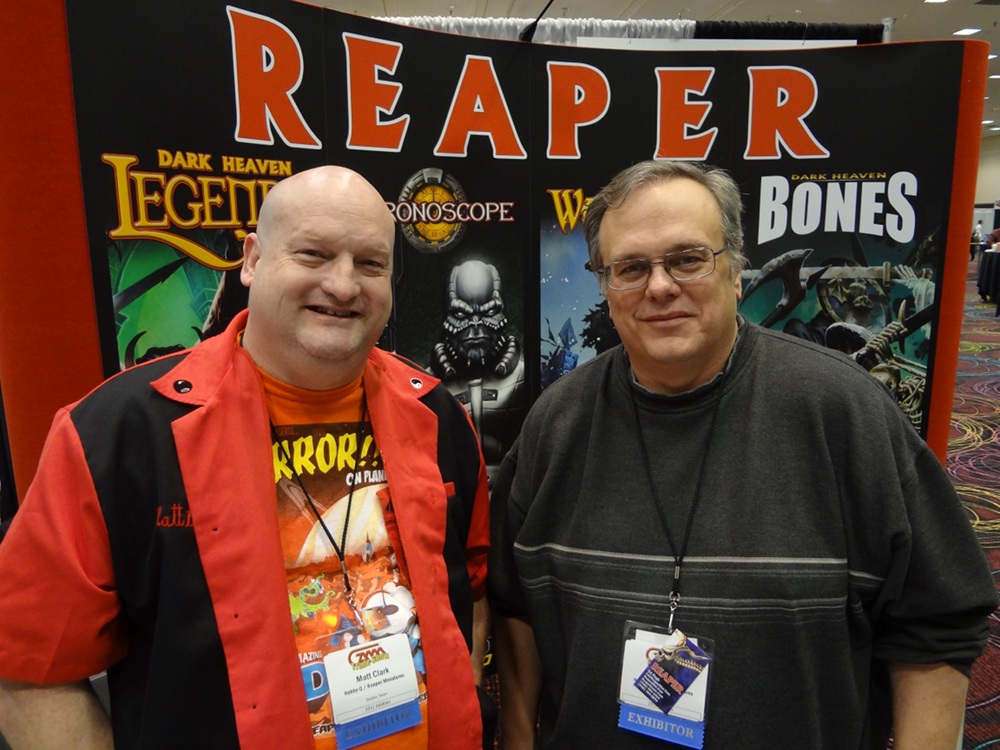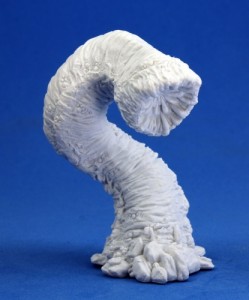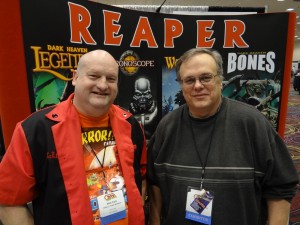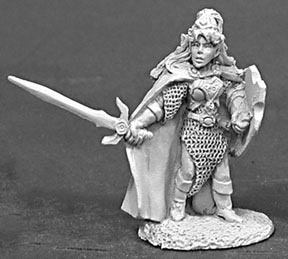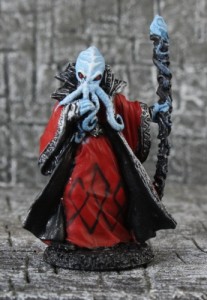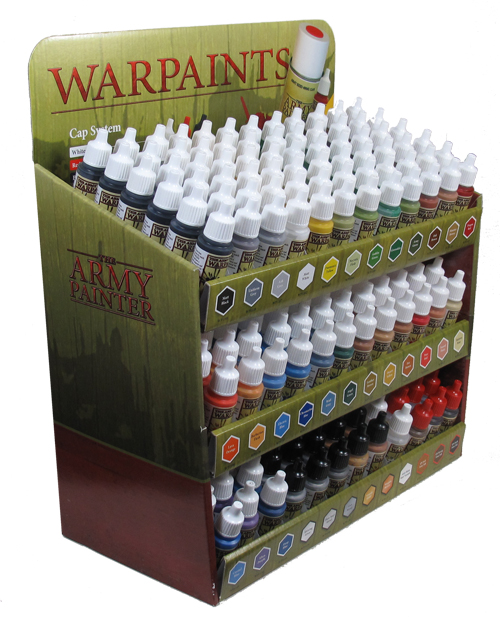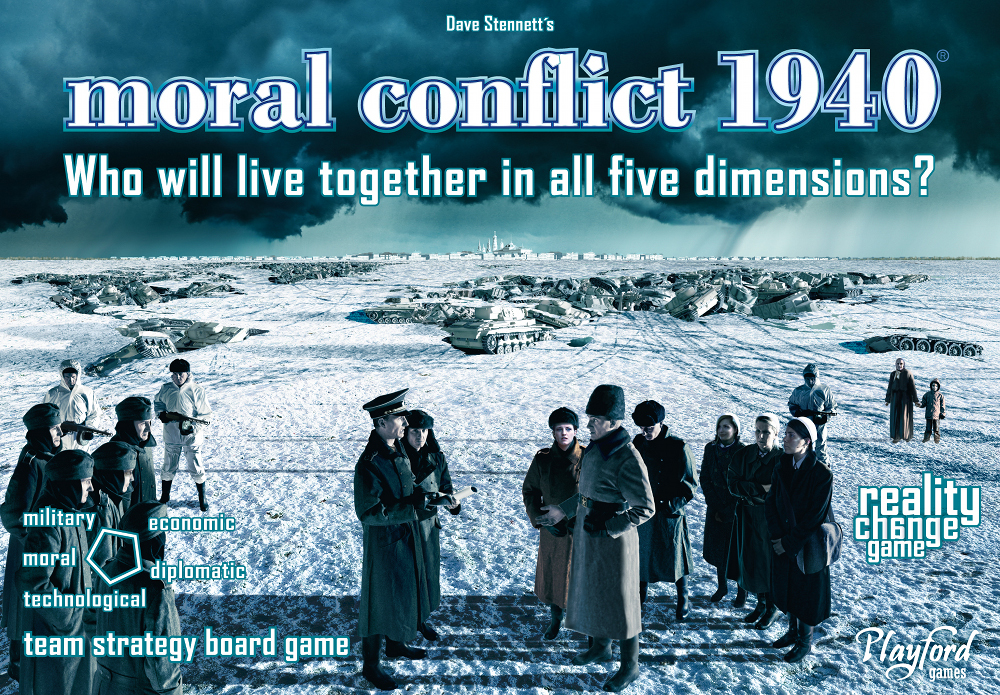Ed Pugh from Reaper Miniatures at the 2012 GAMA Trade Show
I spoke with Ed Pugh, head of Reaper Miniatures, on March 15 at the GAMA Trade Show. I was pleasantly surprised by their move into plastics (Hello, $2.99 Purple Worm!) and tried to wrap my head around Reaper carrying multiple lines of miniatures, as well as several other things about Reaper which I wasn’t expecting.
Reaper Miniatures Bones Plastic Miniatures, Master Series Paints
CG: So I’m here with Ed Pugh from Reaper Miniatures and also three other companies in your Hobby-Q group?
RM: Hobby-Q is a group that has Reaper Miniatures, Master Series Paints, and Asylum Miniatures under it as well as distributes CollectA.
CG: One of the new things you have, just from last week released is… Bones?
RM: Bones, yes. They’re plastic miniatures ready to paint out of the blister. They don’t require primer. You’re more than welcome to prime them, do anything you want. The main focus for us is the price point. They are a fraction of the price of the equivalent piece of metal.
CG: Why do that?
RM: The idea is, is it’s a hobby. You get somebody into this and you get them excited at a paint-and-take or some event like that and then you immediately take them over to a wall, and it’s going to cost them 50 or 75 bucks just to get started. And you lose a lot. We’re not getting a new influx. This will help us get an influx of hobby people. At the price point of $1.99 and $2.49, several figures, paint, they’re in it, they’re in it big.
CG: And so you have a lot of the same sculpts that are in the existing line, but you also have some newer sculpts in this Bones line, that are new?
RM: Yes, they’ll be in the next releases. You’ll have 12 go out in the first release and over the next three months there’ll be 7, 7, and 6, of which 2 are brand new totally to the line, and then 2 will be new to this whole thing as well. But these’ll start getting new releases much like the other lines do. The figure’s done, they’ll go straight into that line. No crossover.
CG: The plastics are being done overseas right now?
RM: Yes, yes, they are being done in China, but our goal is by the end of the year to have it done in house, and to be producing it there in house at Reaper in Denton.
CG: So all of your metal miniatures are made in-house in Denton, Texas?
RM: 100%, yes. We do all of our tooling, we make all our paint there. We mix our paint all the way from scratch from the base materials. Everything is all made there right now. The only thing we don’t produce in-house are our brushes, which we get those done in Italy, and then the plastics.
CG: Speaking of paints, just how big a part of your business are paints?
RM: They’re a substantial part of the business. I don’t want to give a number. I mean yesterday I gave you a number, but I don’t like those floating around in print. But it’s a very very large substantial portion of business. We provide paint around the world and to a lot of different industries as well. Like I told you about the film industry. A lot of the mattes, because we’ll match and they’ll be able to repetitively do whatever their scenework [is] and that kind of stuff. We do a lot of private licensing. Like our first license is this Heavy Gear set.
CG: Speaking of that partnership, how did that work? Who approached who?
RM: They approached us and we had never done any sort of a licensed paint set. So in turn, it was actually, it’s a test for us, it’s a a test for them and see how this goes, if it works successfully. Part of the problem you face is Heavy Gear has a very rabid community like most popular IPs do, but Reaper’s not neccessarily known in that arena and for that community. So will we able to translate? Will their fans go and accept and pick it from us? I mean obviously they’ll be buying it from them, but how does it work? Will it translate in distribution and in the stores and things like that? That’s really our big test. If it works, there’s no telling what you could see. Pathfinder sets, anything.
CG: What about the fact that you have three miniatures, you could have three potential sculpts of the same miniature: prepainted, Bones, you have the classic metal, is this confusing to retailers?
RM: Actually no. While it’s the same item, you have three different consumers. And while it doesn’t sound like it should happen this way, it really does. Metal people will focus on the metal, they’ll get some crossover to look at the Bones, but they’re really over here, ok? They’re already past a lot of these. Bones people are going to be a lot of new people and they’ll eventually work up, and they’ll move over into metal, but they don’t really worry about it, in that sense. The prepainted, again that’s your dungeon crowd. They expect to just get it, pull it out, and put it on the table, they know nothing about painting whether it be metal or this [Bones plastics]. So they’re really, inside a store, and even here, the stores we’re talking to, they’ll carry this line or they’ll carry this line, or sometimes carry both, but you don’t really have much of a crossover. That customer’s there to look for a metal miniature to paint or he’s there to look for a prepainted miniature ’cause he needs a character that night.
Ed Pugh’s Favorite Sculpts, Reaper’s Audience, More About Plastics vs. Metals
CG: Speaking of your whole vast line, what are some of your favorite sculpts of all time?
RM: Personally, I’d go all the way back to 2059, which was an elf girl done by Sandra Garrity. Nowadays there’s so many of them, it’s so hard to pick. I’ve always liked Gauth the Dragon, it was a very large dragon. Our popular characters are really-, our audience is so diverse. For the RPG people, you can literally see, if an RPG company releases a book and in that book, gnomes with swords are popular or something, then you’ll see a lot of those sales with those models start to move out.
CG: You’ve correlated that?
RM: Correlated. At the same time you have the whole gaming community of collectors. They really don’t play the games at all. They just paint and collect and produce and all of that. And in that community, that’s where a lot of these eclectic sculpts that you see that would not really fit into any RPG world, that’s that audience. And even though, they’re in the same line, Dark Heaven, you’ve got again, two or three different demographics going to that same line and buying.
CG: Did I hear you correctly when we spoke yesterday that your audience is more about painters than it is about-
RM: Gamers. Yes, very much. Gamers, the gamer-, let’s say we’ll use Games Workshop. You know they have a very very precisely defined world. And in that world, let’s say they come up with a Duckman and they’ve decided and already told the world what that Duckman looks like and here’s his miniature and here’s his art and it fits. And so even though if we or anybody else produces one, it doesn’t really cross over, because you might find a cooler Duckman, but you put him in there and no one knows who he is. So it’s easier to just buy that company’s figure, whether it’s Privateer Press or Games Workshop or Confrontation or whatever they’re doing. The customer feels comfortable in that environment. For us, RPGs are much more flexible. So that crowd is, you know, playing a dwarf. Well, my dwarf has X. Yours has-, you know, it’s not as strictly confined, so we have that audience in there. Like I said yesterday, Games Workshop, I used to tell people Games Workshop and we have nothing in common other than we make figures out of metal – and now they don’t even do that, so technically, there’s nothing in between the two.
CG: Now that you’ve gone into plastics, has there been a backlash from your metal community.
RM: Not at all.
CG: Because you haven’t eliminated the metal line.
RM: Correct, yes. And I don’t see plastics replacing the metal line. What I see is that plastics – and the way I refer to it is – is PC or not, it’s just another bullet in the chamber, there is no magic. Just like resin figures. We have some resin pieces and we’ve done some, but it’s not an end-all. Metal’s not an end-all. This [plastics] is not going to be an end-all for that. It’s really no different. When WizKids was coming out years ago with MageKnight, the original prepainted plastic, I would get calls from friends in the industry. They’re like “What are you going to do?!” And I’m like “I don’t know, ok? Unless I got 3 million dollars, which I don’t, we’ll find out.” And actually nothing happened. You know, they went out and created a whole new world of consumers that don’t want-, they’re not a hobbyist, “I want to take it out of the box and use it.” And that’s not what we are, we’re more like building models and the hobby side of it.
Reaper’s Prepainted Miniatures and Retail Support
CG: What about your prepainted? Is the painting quality going up?
RM: I like to think our prepainted sets the standard. We started off a little rocky. The difference is is we had to rise really fast, because in our prepainted it’s not blocked, so you see it in the blister. If you don’t like that paint job then you’re not buying it. So the bar got really raised very fast for us and unlike, you know, WotC, I mean they’ve done a great job, but you talk to their consumers and it happens in our store, the notion that “Yeah, looks like this on the box, but don’t expect it to look like that in the package.” It’s sort of like one guy gave me an example of McDonald’s. You go in and look at the picture of the hamburger, it never looks like that when you open yours. So they really didn’t have much of a backlash like that. We got hit pretty hard from that idea, so I like to think that ours are some of the best.
CG: On the internet things like that are hard to judge. Your miniatures are carried in stores, but you also sell on the internet. What do you do as a company in terms of helping retailers. That’s what GAMA Trade Show seems to be all about, “How can you help us? Please help us!” What’s the response been?
RM: Very good. Any retailer that calls us, we can put together a package. We don’t have a standard package, but if you can tell us what you need, we’ll go get you posters, we’ll get you samples, if you’re doing a Grand Opening, if you’re doing an anniversary, if you want to do a paint-n-take, we provide tons of this stuff at no cost. We have plenty of support structures. We have a massive return policy which allows the stores to send weathered product, you know, it’s sun-faded, and they send it back and get credit and they get fresh product. And then when you have laying around, it makes it real easy to go pull samples, and whatever a store might need, so for our end, to help retail stores, we’ll do whatever we can, you know, in that sense.
CG: Do you still-, you mentioned a product code earlier, you just happened to know that one, the elf?
RM: Yeah, 2059. 2059 is the elf, I can’t remember her name now, I don’t have a catalogue. [Calindra Silverspell, pictured earlier]
CG: You just know this off the top of your head?
RM: I know it off the top of my head, yeah. That was one of literally the earliest models and I’m just like “This is cool.” You know, for me. One of the weird things is that we see all of the models so many months before someone else does, 6 months, 8 months, that this is cool, because it’s in our hands and we’re looking at it today. By the time it comes out, the customers are coming up to you and saying “Oh, this is cool!” and you’re going, [unexcited tone] “Yeah. Yeah it is.” I mean I’m looking at something that you’re not going to see for 8 months.
CG: What number of sculpts are you on in terms of miniatures made?
RM: Oh, we have 5,000, I think. If you add everything together, 5-6,000, if you go by pieces. Probably about 4-5,000 in SKUs, probably 5-7,000 in pieces, because you know, a model might be 3 or 4 pieces.
CG: Do you still have a hand in approving artwork, concept artwork?
RM: No.
CG: That’s someone else?
RM: Ron Hawkins is the Art Director. He does that almost entirely. And in fact too, I’ve been asking for several years to get an Undead Pirate and still haven’t seen it, so I don’t have much better luck than a lot of other people trying to get what they want.
